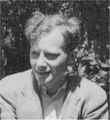Template:Selected anniversaries/November 11: Difference between revisions
Jump to navigation
Jump to search
No edit summary |
No edit summary |
||
| Line 24: | Line 24: | ||
||Raemer Edgar Schreiber (b. November 11, 1910) was an American physicist from McMinnville, Oregon who served Los Alamos National Laboratory during World War II, participating in the development of the atomic bomb. He saw the first one detonated in the Trinity nuclear test in July 1945, and prepared the Fat Man bomb that was used in the bombing of Nagasaki. After the war, he served at Los Alamos as a group leader, and was involved in the design of the hydrogen bomb. In 1955, he became the head of its Nuclear Rocket Propulsion (N) Division, which developed the first nuclear-powered rockets. Pic. | ||Raemer Edgar Schreiber (b. November 11, 1910) was an American physicist from McMinnville, Oregon who served Los Alamos National Laboratory during World War II, participating in the development of the atomic bomb. He saw the first one detonated in the Trinity nuclear test in July 1945, and prepared the Fat Man bomb that was used in the bombing of Nagasaki. After the war, he served at Los Alamos as a group leader, and was involved in the design of the hydrogen bomb. In 1955, he became the head of its Nuclear Rocket Propulsion (N) Division, which developed the first nuclear-powered rockets. Pic. | ||
||Enzo Martinelli | ||1911: Enzo Martinelli born ... mathematician, working in the theory of functions of several complex variables: he is best known for his work on the theory of integral representations for holomorphic functions of several variables, notably for discovering the Bochner–Martinelli formula in 1938, and for his work in the theory of multi-dimensional residues. | ||
||1914 | ||1914: James Gilbert Baker born ... astronomer, optician, and academic. Pic. | ||
||Roberto Mario "Robert" Fano | ||1917: Roberto Mario "Robert" Fano born ... computer scientist and academic. He was known principally for his work on information theory, inventing (with Claude Shannon) Shannon–Fano coding and deriving the Fano inequality. He also invented the Fano algorithm and postulated the Fano metric. Pic. | ||
|| | ||1921: Morton Landers Curtis born ... mathematician, an expert on group theory. Together with Gustav A. Hedlund and Roger Lyndon, he proved the Curtis–Hedlund–Lyndon theorem characterizing cellular automata as being defined by continuous equivariant functions on a shift space. Pic: search book cover. | ||
|| | ||1926: The United States Numbered Highway System is established. | ||
||1930 | ||1930: Hugh Everett III born ... physicist and mathematician. | ||
||Mildred Dresselhaus | ||1930: Patent number US1781541 is awarded to Albert Einstein and Leó Szilárd for their invention, the Einstein refrigerator. | ||
||1930: Mildred Dresselhaus born ... known as the "queen of carbon science" | |||
||1940 – World War II: The German auxiliary cruiser Atlantis captures top secret British mail from the Automedon, and sends it to Japan. | ||1940 – World War II: The German auxiliary cruiser Atlantis captures top secret British mail from the Automedon, and sends it to Japan. | ||
Revision as of 17:35, 27 August 2018
1675: Mathematician Gottfried Leibniz demonstrates integral calculus for the first time to find the area under the graph of y = ƒ(x).
1875: Astronomer Vesto Melvin Slipher born. He will perform the first measurements of radial velocities for galaxies, providing the empirical basis for the expansion of the universe.
1904: Mathematician and academic J. H. C. Whitehead born. During the Second World War, he will work with the codebreakers at Bletchley Park.
1930: Physicist Hugh Everett III born. He will propose the many-worlds interpretation (MWI) of quantum physics.
1933: Cantor Parabola warns that crimes against mathematical constants are on the rise.
2005: The Venus Express successfully performs its first trajectory correction maneuver.





